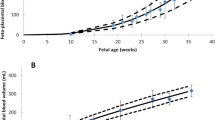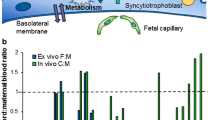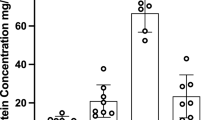Summary
The distribution of phenobarbital (PB) in whole blood and its fractions in 8 pregnant women, in 10 mothers and infant pairs at delivery and in 7 controls was studied by equilibrium dialysis. The lowest protein binding was in cord plasma. A correlation was found between the maternal and cord plasma PB binding. The adult plasma PB binding ratio was correlated with the molar albumin concentration, but no such relation was found in cord plasma, suggesting inhibition of binding by other factors. As a counterpart to the lower protein binding in maternal and cord plasma, the fraction of PB distributed to erythrocytes in those groups was significantly higher. The apparent concentration of PB in maternal erythrocytes was increased. The distribution of drugs to the various fractions of whole blood is an important consideration perinatally, since the binding characteristics of plasma and blood cells in mother and fetus will be crucial determinants for the placental transfer of drugs.
Similar content being viewed by others
References
McArthur JN, Dawkins PO, Smith MJH (1971) The binding of indomethacin, salicylate and phenobarbitone to human whole blood in vitro. J Pharm Pharmacol 23: 32–36
Ehrnebo M, Agurell S, Boréus LO, Gordon E, Lönroth U (1974) Pentazocine binding to blood cells and plasma proteins. Clin Pharmacol Ther 16: 424–429
Herngren L, Ehrnebo M, Boréus LO (1982) Drug distribution in whole blood of mothers and their newborn infants. Eur J Clin Pharmacol 22: 351–358
Hagenfeldt L (1966) A gas chromatographic method for the determination of individual free fatty acids in plasma. Clin Chim Acta 13: 266–268
Bergström K, Lefwert AK (1980) An automatical turbidimetric immunoassay for plasma proteins. Scand J Clin Lab Invest 40: 637–641
Michaelsson M (1972) Evaluation of a method for determination of bilirubin in serum using direct spectrophotometry. Scand J Clin Lab Invest 30: 387–390
Jusko WJ, Gretch M (1976) Plasma and tissue protein binding of drugs in pharmacokinetics. Drug Metab Rev 5: 43–140
Wadell WJ, Butler TC (1957) The distribution and excretion of phenobarbital. J Clin Invest 36: 1217–1226
Ploman L, Persson BH (1957) On the transfer of barbiturates to the human faetus and their accumulation in some of its vital organs. J Obstet Gynecol 64: 706–711
Melchior JC, Svensmark O, Trolle D (1967) Placental transfer of phenobarbitone in epileptic women, and elimination in newborns. Lancet 2: 860–861
Jalling B, Boréus LO, Kållberg N, Agurell S (1973) Disappearance from the newborn of circulating prenatally administered phenobarbital. Eur J Clin Pharmacol 6: 234–238
Boréus LO, Jalling B, Wallin A (1978) Plasma concentrations of phenobarbital in mother and child after combined prenatal and postnatal administration for prophylaxis of hyperbilirubinemia. J Pediatr 93: 695–698
Ehrnebo M, Agurell S, Jalling B, Boréus LO (1971) Age differences in drug binding by plasma proteins: Studies on human features, neonates and adults. Eur J Clin Pharmacol 3: 189–193
Kurz H, Mauser-Gaushorn A, Stickel HH (1977) Differences in the binding of drugs to plasma proteins from newborn and adult man. Eur J Clin Pharmacol 11: 463–467
Stock B, Dean M, Levy G (1980) Serum protein binding of drugs during and after pregnancy in rats. J Pharmacol Exp Ther 212: 264–268
Brodersen R (1978) Free bilirubin in blood plasma of the newborn: Effects of albumin, fatty acids, pH, displacing drugs and phototherapy. In: Stern L, Oh W, Friis-Hansen B (eds) Intensive care in the newborn, vol II. Mason Publishing USA, New York
Wallin A, Boréus LO (1984) Phenobarbital prophylaxis for hyperbilirubinemia in preterm infants: A controlled study of bilirubin disappearance and infant behavior. Acta Paediatr Scand 73: 488–497
Friis-Hansen B (1961) Body water compartments in children: Changes during growth and related changes in body composition. Pediatrics 28: 169–181
Worley RJ, Heutschel WM, Cormier C, Nutting S, Pead G, Zelenkov K, Smith JB, Ash KO, Williams RR (1982) Increased sodium-lithium countertransport in erythrocytes of pregnant women. N Engl J Med 307: 412–416
Sheetz MP, Singer SJ (1974) Biological membranes as bilayer couples. A molecular mechanism of drug-erythrocyte interactions. Proc Natl Acad Sci (USA) 71: 4457–4461
Author information
Authors and Affiliations
Rights and permissions
About this article
Cite this article
Wallin, A., Herngren, L. Distribution of phenobarbital in whole blood during pregnancy and perinatally — An in vitro study. Eur J Clin Pharmacol 29, 187–191 (1985). https://doi.org/10.1007/BF00547420
Received:
Accepted:
Issue Date:
DOI: https://doi.org/10.1007/BF00547420




